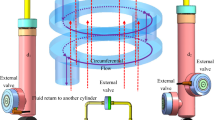Abstract
In the field of flow control, autonomously regulated valves that exclude any moving parts are extremely reliable, yet research on these devices is sparse. Aiming toward better understanding of their hydrodynamics, our study used a three-dimensional (3D) computational fluid dynamics (CFD) model to describe the velocity fields and pressure differentials in a fluidic device with no moving components and two tangential inlet nozzles that induced swirl within a circular cavity. Specifically, flows at high Reynolds number values (for which inertia dominates) followed the tangential path and resulted in higher pressure loss because of induced rotation within the circular cavity. Flows at lower Reynolds number values followed the pressure gradient toward the outlet and exited the tangential path via radial channels, lowering the overall pressure loss. The distribution of the flow through the various radial passages was calculated for different regimens and correlated to the Reynolds numbers. The observed streamlines and pressure differential trend corroborated the design intent of the Reynolds-Number-Sensitive Fluidic Resistor (RNSFR), which intends to separate different fluids based on their viscosity. Particle image velocimetry (PIV) measurements were performed to validate the computations.












Similar content being viewed by others
References
Zobel, R.: Experiments on a hydraulic reversing elbow. Mitt. Hydr. Inst. Munich. 8, 1–47 (1936)
Tesar, V.: Fluidic Control of Molten Metal Flow. 43
Tesar, V., Hung, C.H., Zimmerman, W.B.: No-moving-part hybrid-synthetic jet actuator. Sensors Actuators A Phys. 125, 159–169 (2006). https://doi.org/10.1016/j.sna.2005.06.022
Scanlon, T., Wilson, P., Priestman, G., Tippetts, J.: Development of a novel flow control device for limiting the efflux of air through a failed pipe. In: ASME Turbo Expo 2009: Power for Land, Sea, and Air, pp. 1217–1227 (2009)
Tesar, V.: Extremely simple pressure regulator–computation studies. Chem. Eng. J. 155, 361–370 (2009)
Rietema, K., Krajenbrink, H.J.: Theoretical derivation of tangential velocity profiles in a flat vortex chamber-influence of turbulence and wall friction. Appl. Sci. Res. 8, 177–197 (1959). https://doi.org/10.1007/BF00411748
Henke, R.W.: Application of Fluidics. Ind. Gen. Appl. IEEE Trans IGA-4, 490–500 (1968)
Tanney, J.W.: Fluidics. Prog. Aerosp. Sci. 10, 401–509 (1970)
Dykstra, J.D., Fripp, M.L., Hamid, S.: Flow path control based on fluid characteristics to thereby variably resist flow in a subterranean well (2012)
Dykstra, J.D., Fripp, M.L., Holderman, L.W.: Variable flow restrictor for use in a subterranean well (2013)
Fripp, M., Zhao, L., Least, B., et al.: The theory of a fluidic diode autonomous inflow control device. In: SPE Middle East intelligent energy conference and exhibition (2013)
Greci, S., Least, B., Tayloe, G., et al.: Testing results: erosion testing confirms the reliability of the fluidic diode type autonomous inflow control device. In: Abu Dhabi international petroleum exhibition and conference (2014)
Zeng, Q., Wang, Z., Wang, X., Wei, J., Zhang, Q., Yang, G.: A novel autonomous inflow control device design and its performance prediction. J. Pet. Sci. Eng. 126, 35–47 (2015)
Reba, I.: Applications of the Coanda effect. Sci. Am. 214, 84–92 (1966)
Oh, K.W., Ahn, C.H.: A review of microvalves. J. Micromech. Microeng 16, R13 (2006)
Wileman, A., Least, B., Greci, S., Ufford, A., et al.: Fluidic diode autonomous inflow control device range 3B-oil, water, and gas flow performance testing. In: SPE Kuwait oil and gas show and conference (2013)
Ansys Inc.: Fluent User Guide. v. 15.0 (2013)
Shih, T.-H., Liou, W.W., Shabbir, A., Yang, Z., Zhu, J.: A new k-epsilon eddy viscosity model for high Reynolds number turbulent flows: Model development and validation. NASA STI/Recon Tech. Rep. 95, 11442 (1994)
Kulkarni, A.A., Ranade, V.V., Rajeev, R., Koganti, S.B.: CFD simulation of flow in vortex diodes. AIChE J. 54, 1139–1152 (2008). https://doi.org/10.1002/aic.11439
Ansys Inc.: Fluent Theory Guide. v. 15.0 (2013)
Hreiz, R., Gentric, C., Midoux, N.: Numerical investigation of swirling flow in cylindrical cyclones. Chem. Eng. Res. Des. 89, 2521–2539 (2011). https://doi.org/10.1016/j.cherd.2011.05.001
Roache, P.J.: Perspective: a method for uniform reporting of grid refinement studies. Trans. Soc. Mech. Eng. J. Fluids Eng. 116, 405 (1994)
Least, B., Greci, S., Burkey, R.C., Ufford, A., Wilemon, A., et al.: Autonomous ICD single phase testing. In: SPE Annual Technical Conference and Exhibition (2012)
Halliburton: EquiFlow Autonomous Inflow Control Device. http://www.halliburton.com/en-US/ps/completions/sand-control/screens/inflow-control/equiflow-autonomous-inflow-control-device.page?node-id=hfqel9w4# (2017)
Acknowledgments
The author would like to thank the financial and technical support from Halliburton Energy Services, Inc. Additional appreciation is extended to the Ohio Supercomputer Center for their technical support.
Funding
This study was funded by Halliburton Energy Services, Inc.
Author information
Authors and Affiliations
Corresponding author
Ethics declarations
Conflict of interests
The authors declare that they have no conflict of interest.
Additional information
Publisher’s Note
Springer Nature remains neutral with regard to jurisdictional claims in published maps and institutional affiliations.
Rights and permissions
About this article
Cite this article
Farbos de Luzan, C., Villalva, R., Felten, F. et al. Computational Study of the Velocity Fields and Pressure Differential in a Reynolds-Number-Sensitive Fluidic Resistor. Flow Turbulence Combust 102, 221–234 (2019). https://doi.org/10.1007/s10494-018-9952-0
Received:
Accepted:
Published:
Issue Date:
DOI: https://doi.org/10.1007/s10494-018-9952-0




